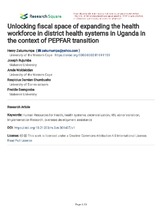Unlocking scal space of expanding the health workforce in district health systems in Uganda in the context of PEPFAR transition
Abstract
Although expanding fiscal space for health worker recruitments could reduce workforce shortages in Sub-Saharan Africa, effective strategies for achieving this are still unclear. We aimed to understand the process of transitioning health workers (HWs) from PEPFAR to Government of Uganda (GoU) payrolls and to explore the facilitators and barriers encountered in increasing domestic financial responsibility for absorbing this transitioned workforce. We conducted a multiple case-study of 10 (out of 87) districts in Uganda which received PEPFAR support between 2013 and 2015 to expand their health workforce. We purposively selected eight districts with the highest absorption rates (‘High absorbers’) and two with the lowest absorption rates (‘Low absorbers’). A total of 66 interviews were conducted with high-level officials in three Ministries of Finance, Health and Public Service (n = 14), representatives of PEPFAR implementing organizations (n = 16), District Health Teams (n = 15) and facility managers (n = 22). Twelve focus groups were conducted with 87 HWs absorbed on GoU payrolls. We utilized the Consolidated Framework for Implementation Research (CFIR) to guide thematic analysis.
At sub-national level, facilitators of transition in ‘high absorber’ districts were identified as the presence of transition ‘champions’, prioritizing HWs in district wage bill commitments, host facilities providing ‘bridge financing’ to transition workforce during salary delays and receiving donor technical support in district wage bill analysis- attributes which were absent in ‘low absorber’ districts. At national-level, multi-sectoral engagements (incorporating the influential Ministry of Finance), developing a joint transition road map, aligning with GoU salary scales and recruitment processes emerged as facilitators of the transition process.
Overall, PEPFAR support acted as a catalyst for increasing GoU and facility-level budget allocations towards expanding the health workforce in focus districts in Uganda. Our case-studies offer implementation research lessons on effective donor transition and insights into pragmatic strategies for expanding fiscal space for health in a low-income setting.

